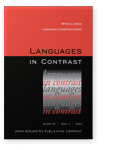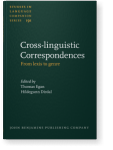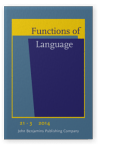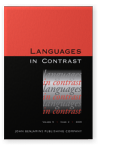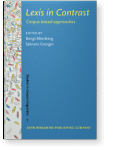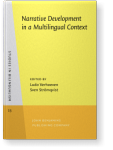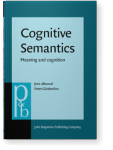Åke Viberg
List of John Benjamins publications for which Åke Viberg plays a role.
Journal
2021 Why is smell special? A case study of a European language: Swedish The Linguistics of Olfaction: Typological and Diachronic Approaches to Synchronic Diversity, Jędrzejowski, Łukasz and Przemysław Staniewski (eds.), pp. 35–72 | Chapter
Recent typological studies have described a number of languages with a rich inventory of abstract odor terms, which stand in stark contrast to Swedish and other European languages that are considered to have poor systems of such terms. However, there have been few thorough descriptions of the odor… read more
2017 Chapter 2. Saying, talking and telling : Basic verbal communication verbs in Swedish and English Cross-linguistic Correspondences: From lexis to genre, Egan, Thomas and Hildegunn Dirdal (eds.), pp. 37–74 | Chapter
This study compares the major Verbal Communication Verbs (VCVs) in English say, tell, speak and talk with their Swedish correspondents säga, berätta, tala and prata. The analysis is based on data from the English–Swedish Parallel Corpus. The semantic and functional description of the verbs is based… read more
2015 Sensation, perception and cognition: Swedish in a typological-contrastive perspective Sensory Perceptions in Language and Cognition, Caballero, Rosario and Carita Paradis (eds.), pp. 96–131 | Article
This paper presents an analysis of the field of perception verbs in Swedish within a typological and contrastive framework. Earlier work has to a great extent focused on the concepts see and hear. This article focuses on the more ‘raw’ form of perception represented by sensations and on the… read more
2014 Review of Hanks (2013): Lexical Analysis: Norms and Exploitations Functions of Language 21:3, pp. 366–373 | Review
2013 Posture verbs: A multilingual contrastive study Text-based contrastive linguistics, Altenberg, Bengt and Karin Aijmer (eds.), pp. 139–169 | Article
From a typological perspective, the verbs of sitting, standing and lying have been described relatively extensively. Against this background, the present paper provides a contrastive study of the lexical semantics of the Swedish posture verbs sitta ‘sit’, stå ‘stand’ and ligga ‘lie’ based on the… read more
2013 Seeing the lexical profile of Swedish through multilingual corpora: The case of Swedish åka and other vehicle verbs Advances in Corpus-based Contrastive Linguistics: Studies in honour of Stig Johansson, Aijmer, Karin and Bengt Altenberg (eds.), pp. 25–56 | Article
The typological distinction between verb-framed and satellite-framed languages is informative but is today regarded rather as a continuum and needs to be supplemented with more fine-grained distinctions. This paper presents a corpus-based contrastive study of Swedish verbs describing motion in a… read more
2008 Swedish verbs of perception from a typological and contrastive perspective Languages and Cultures in Contrast and Comparison, Gómez González, María de los Ángeles, J. Lachlan Mackenzie and Elsa M. González Álvarez (eds.), pp. 123–172 | Article
Verbs of perception hold a central position among mental verbs. What makes such verbs particularly interesting is their complex patterns of polysemy that both show crosslinguistic regularities and language-specific (or area-specific) characteristics. This paper accounts for the major semantic… read more
2005 The lexical typological profile of Swedish mental verbs Contrast in Context, Aijmer, Karin, Hilde Hasselgård and Stig Johansson (eds.), pp. 121–157 | Article
The lexical typological profile of a language is a crosslinguistically valid characterization of its lexical structure with particular focus on basic features which are language-specific. The paper deals with basic mental verbs in Swedish from this perspective based on data from translation corpora… read more
2003 The polysemy of the Swedish verb komma ‘come’: A view from translation corpora Meaning Through Language Contrast: Volume 2, Jaszczolt, Katarzyna M. and Ken Turner (eds.), pp. 75–105 | Article
2002 Polysemy and disambiguation cues across languages: The case of Swedish få and English get Lexis in Contrast: Corpus-based approaches, Altenberg, Bengt and Sylviane Granger (eds.), pp. 119–150 | Chapter
2001 4. Age-related and L2-related features in bilingual narrative development in Sweden Narrative Development in a Multilingual Context, Verhoeven, Ludo and Sven Strömqvist (eds.), pp. 87–128 | Chapter
1999 Polysemy and Differantiation in the Lexicon Cognitive Semantics: Meaning and cognition, Allwood, Jens and Peter Gärdenfors (eds.), pp. 87–130 | Article
1999 The Polysemous Cognates Swedish gå and English go: Universal and language-specific characteristics Information Structure in Parallel Texts, Hasselgård, Hilde, Stig Johansson and Cathrine Fabricius-Hansen (eds.), pp. 87–113 | Article
In spite of the fact that Swedish gå and English go are historically rather closely related in a transparent way, both verbs are translated by their etymological counterpart only in around one third of the cases, as evidenced from the English-Swedish Parallel Corpus. The article compares the… read more
